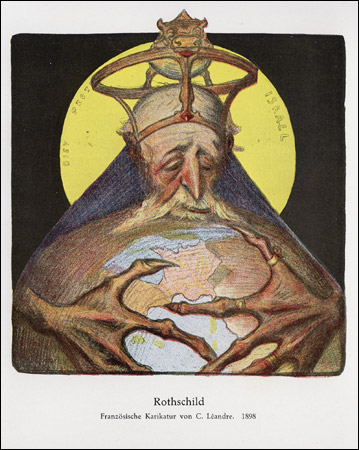 Sunday, August 241, 2005 8:36
AM The
Anti-Collector By Boris
Fishman Photo:
French 19th Century
caricature of a Jewish banker --
Illustration
from "Die Juden in der Karikatur" by
Eduard Fuchs (1921) EARLIER this year, as
England
marked Holocaust Memorial Day on Jan. 27,
an advertisement appeared on the Labour
Party Web site likening Michael
Howard, the Jewish leader of the
opposition Conservative Party, to Fagin,
the iconic stereotype of the miserly,
conniving Jew in Charles Dickens's
"Oliver Twist."  For
the Anglo-Jewish community, it was a
familiar coincidence. Two years before,
the Jan. 27th issue of The
Independent, the left-of-center
British newspaper, carried a cartoon of a
disrobed Ariel Sharon devouring a
blood-soaked Palestinian child under the
words: "What's wrong . . . you never seen
a politician kissing babies before?" For
the Anglo-Jewish community, it was a
familiar coincidence. Two years before,
the Jan. 27th issue of The
Independent, the left-of-center
British newspaper, carried a cartoon of a
disrobed Ariel Sharon devouring a
blood-soaked Palestinian child under the
words: "What's wrong . . . you never seen
a politician kissing babies before?"
The Howard image provoked criticism and
was quickly withdrawn. However, the
Independent cartoon, which was
accused of evoking the medieval "blood
libel" that Jews extract the blood of
Christian children to make Passover
matzoh, will appear in an exhibit of
anti-Semitic imagery next March. Its organizer, a London physician named
Simon Cohen, has single-mindedly
gathered nearly 300 items of
anti-Semitica, from medieval depictions of
Jews murdering Christian children to Nazi
propaganda denigrating Jews as subhuman
parasites to modern anti-Israel imagery
supposedly based on anti-Semitic
stereotypes. Cohen is an Orthodox Jew. (There are
two kinds of people who collect
anti-Semitica, a collector once declared
in the Jewish weekly The Forward:
neo-Nazis and Jews.) He says he hopes his
show will educate and thereby chasten
those who cavalierly invoke anti-Semitic
language or iconography. But is exhibiting
hate art the way to discourage hate? The
Anglo-Jewish community isn't so sure. In public, Cohen is bashful about his
collecting habit, but at his home in
Golders Green, a Jewish neighborhood in
North London, he couldn't restrain his
enthusiasm. "This is brilliant," he said,
pointing to a German image of a portly
Jewish tycoon peering lecherously at a
young Christian woman.  "This
is really disgusting." An international
parade of anti-Semitic materials followed:
Dutch, Finnish and Italian posters
accusing Jews of warmongering and
conspiring to dominate the world; a German
image accusing Jews of spreading
communism; a Soviet image accusing Jews of
spreading capitalism; a Serbian image
accusing Jews of spreading communism and
capitalism. "This
is really disgusting." An international
parade of anti-Semitic materials followed:
Dutch, Finnish and Italian posters
accusing Jews of warmongering and
conspiring to dominate the world; a German
image accusing Jews of spreading
communism; a Soviet image accusing Jews of
spreading capitalism; a Serbian image
accusing Jews of spreading communism and
capitalism. "My enthusiasm for these things is
inappropriate," he said sheepishly. Jewish collectors of anti-Semitica are
unlike most serious collectors in that
they are repelled by their subject and
exactly like them in that they are
obsessively acquisitive. Their demand has
helped to create a market, even if it's
largely underground. The material is
especially abundant in the formerly
Nazi-occupied countries of Europe, like
France and Poland, where anti-Semitica was
produced virtually as a matter of state
policy during World War II. Cohen's interest in anti-Semitica began
after his daughter's brother-in-law was
killed in a suicide bombing in Israel. A
dealer had shown Cohen, already a
collector of Judaica, an 1889 French
electoral poster for "Ad. Willette,
Candidat Antisémite," which, next
to the proclamation "The Jews are only
great because we are on our knees,"
featured several Frenchmen expelling a
hooknosed, humpbacked Jew. Cohen, who had been alarmed by the
spread of what he regarded as similar
images in Middle Eastern and Western
European newspapers, had an idea. He would
mount a chronological exhibit of
anti-Semitica "to show the relationship
between the images." He hoped the
exhibit's logic would convince those like
Dave Brown, the creator of The
Independent's Ariel Sharon cartoon,
who, in Cohen's view, had invoked an
anti-Semitic stereotype and then denied
the lineage. (Brown made the credible
claim that he was channeling Goya's
"Saturn Devouring One of His Sons"
instead.) If Brown's image looked exactly
like those in the Nazi propaganda
newspaper Der Stürmer, Cohen's
reasoning went, the unsavory pedigree
would be undeniable and would deter
others. "I want to make sure that the images
aren't interpreted as legitimate
anti-Israel cartoons," Cohen said. "People
don't have to agree with the policies of
Sharon. But I draw the line if you show
him drinking blood." Cohen initially hoped to show his
collection in the United States, but a
tour of several potential venues -- the
Anti-Defamation
League, the Simon
Wiesenthal Center, the American Jewish
Committee -- ended inconclusively. "We
feature anti-Semitica, but within a larger
exhibit on the Holocaust," explained
Louis Levine of the Museum of
Jewish Heritage in New York. "You don't
want to dignify anti-Semitica by making it
the sole subject of an exhibit." Boris Fishman writes for The New
Yorker, The New Republic and The
Nation.   Our dossier on the
origins of anti-Semitism
Our dossier on the
origins of anti-Semitism
|